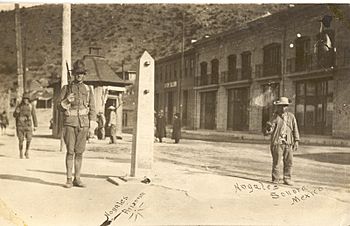Battle of Nogales (1915) facts for kids
Quick facts for kids Second Battle of Nogales |
||||||
|---|---|---|---|---|---|---|
| Part of the Mexican Revolution, Border War | ||||||
 American and Mexican soldiers guarding International Street in Ambos Nogales. The obelisk in the center is a border marker, which still stands today. |
||||||
|
||||||
| Belligerents | ||||||
|
|
|
|||||
| Commanders and leaders | ||||||
| unknown | ||||||
| Casualties ~70 killed or wounded | ||||||
The Second Battle of Nogales was a battle involving three groups during the Mexican Revolution. It happened in November 1915 in the border towns of Nogales, Sonora, Mexico, and Nogales, Arizona, United States.
On the morning of November 26, rebel forces led by Pancho Villa were in Nogales, Sonora. They started shooting at United States Army soldiers in Nogales, Arizona. The American soldiers fired back for over two hours. Then, another Mexican group called the Constitutionalists (also known as Carrancistas) arrived. They attacked Villa's forces. Later that day, the Constitutionalists accidentally shot at American soldiers. This led to another short fight. This battle was the first important fight between Villa's forces and the United States military. Several Mexicans died during the conflict.
Contents
The Battle Begins
In November 1915, Pancho Villa was fighting in the Battle of Agua Prieta. He eventually lost this battle. Villa was low on soldiers and supplies. So, he sent some of his troops to Nogales, Sonora. They took over the town without any fighting.
Soon after, some attacks happened across the border into Arizona. It's not clear who was behind these attacks. Both Villa's group and the Constitutionalists were known for raiding in southern Arizona. However, it was most likely Villa's soldiers.
Why Villa Attacked
According to a writer named Francisco Arturo Rosales, Villa had a reason for these actions. He wanted to get back at the United States. He felt the U.S. had helped the Constitutionalist forces at Agua Prieta. Villa also wanted to make the border area unstable. This would make it harder for Mexico's President, Venustiano Carranza, to control the region.
Early Border Incidents
On November 21, two Buffalo Soldiers from the 10th Cavalry were shot at. They were watching the border near "Monument 117." The soldiers fired back, and Private Willie Norman was wounded.
The next day, five armed Mexicans attacked a small camp of 10th Cavalry soldiers. This happened along the Santa Cruz River near Nogales, Arizona. The soldiers used their revolvers and killed two of the attackers.
On November 25, some "guerrillas" crossed the border. They attacked a 10th Cavalry outpost protecting Mascarena's Ranch. Again, soldiers from Troop F fought them off. One Mexican was wounded and captured.
Main Conflict Erupts
The situation became much more serious the next day. Villa's snipers were leaving Nogales, Sonora. They started shooting at American soldiers from the 12th Infantry. These American soldiers were guarding the border in Nogales, Arizona.
In response, the American commander, Colonel William H. Sage, ordered his men to get ready for battle. They formed a line along International Street. This dirt road marked the border between the two Nogales towns. Some American snipers also took positions on rooftops. They could see the border clearly.
At about 10:00 AM, Colonel Sage gave the order to fire. He made sure his soldiers only shot at the hostile Mexicans. They avoided hitting any civilians. Some American units crossed the border during the fight.
Constitutionalists Arrive
Around 12:40 PM, General Alvaro Obregon and his Constitutionalist army arrived. Colonel Sage then told his men to stop firing and return to their camp. Obregon's army continued fighting Villa's forces for some time. The Americans watched from the border line.
Accidental Second Skirmish
However, later that day, some 10th Cavalry guards were shot at. Obregon's troops fired at them from a hill. The Buffalo Soldiers fought the Mexicans for thirty minutes, killing two. Eventually, another cease-fire was ordered. The commanders from both sides apologized to each other. Obregon's men said they had thought the American soldiers were Villa's troops.
Aftermath of the Battle
Only one American soldier is known to have died. He was Private Stephen D. Little from the 12th Infantry Regiment. Five other Americans were wounded. However, some reports say as many as three Americans died. Francisco Rosales, a writer, states that the Americans killed sixty Mexicans and wounded many more.
Camp Stephen D. Little
To honor Private Little, the War Department changed the name of Camp Nogales. It became Camp Stephen D. Little. This base grew to hold over 10,000 soldiers by 1916. The camp was located along what is now Western Avenue, from Grand Avenue to Interstate 19.
Later Incidents with Pancho Villa
The next major event involving Americans and Pancho Villa happened on January 11, 1916. Villa's forces stopped a train near San Ysabel, Chihuahua, Mexico. They forced seventeen American passengers off the train at gunpoint. Then, they shot all of them. Only one man survived by pretending to be dead. He later crawled away from the site.
The victims were mining engineers who worked for ASARCO. Mexico's President Carranza had invited them to Mexico. They were going to reopen the Cusihuiriachic mines south of Chihuahua.
U.S. Response
President Woodrow Wilson first chose not to get involved in Mexico because of this attack. However, on March 9, 1916, Pancho Villa attacked the town of Columbus, New Mexico. He killed eighteen Americans and burned several buildings. After this, President Wilson ordered General Pershing to start the Mexican Expedition. This was an effort to capture or kill Pancho Villa.

